Water Quality Testing
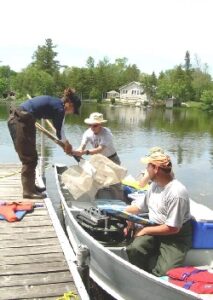 Surface water quality continues to be the most important issue to Otty Lake residents. The water quality on Otty Lake has been measured since 1971, although what has been measured and the techniques that were used have changed over time. (For more on the history of water quality monitoring, see the 2007 State of the Lake Report.) Since 2014, a more brief State of the Lake report has been created every fall; in it the water quality results for the year are summarized. See these annual reports on our Environment page.
Surface water quality continues to be the most important issue to Otty Lake residents. The water quality on Otty Lake has been measured since 1971, although what has been measured and the techniques that were used have changed over time. (For more on the history of water quality monitoring, see the 2007 State of the Lake Report.) Since 2014, a more brief State of the Lake report has been created every fall; in it the water quality results for the year are summarized. See these annual reports on our Environment page.
The sampling results from the RVCA for 2023 for Otty and Mclaren Lake are below (files in Excel):
E.coli Sampling at Otty Lake
The forerunner to the current lake association began sampling for bacteria levels by measuring fecal counts in Otty Lake in 1971. In 2001, sampling for fecal counts was replaced by E.coli sampling as it is a more specific indicator of the bacteria that affect human health.
We are unable to sample the entire lake for E.coli at the frequency of a monitored public swimming beach. Nevertheless, these recorded values of E.coli would indicate that Otty can be generally regarded as a safe lake for swimming. Drinking untreated lake water is not advised.
The chart below shows the percentage of E.coli samples with values of cfu/100 mL in a certain range, in a given year.
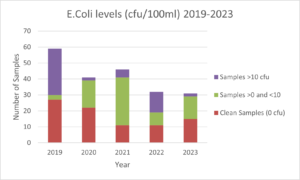
Phosphorus Measurements
Total Phosphorus is sampled as a measurement of nutrient loading of the Lake – higher levels can affect the health of the Lake, promoting algal blooms and excessive aquatic plant growth. We can all do our part to reduce nutrient loading at Otty by avoiding the use of fertilizers, ensuring that septic systems are in proper working order and creating vegetated shoreline buffer zones that will take up nutrients before they reach the lake.
-
Total Phosphorus sampling is carried out by the OLA through the Lake Partner Program of the Ministry of the Environment, Parks and Conservation (MOEPC).
-
Samples are taken six times annually, from mid-May to mid-October
-
Results since 2002 are available online under this program
-
Currently over 600 Ontario lakes are participating in this program
-
The average value of Total Phosphorus sampled at Otty Lake in 2018 under the Lake Partners Program was 13.5 micrograms/Litre
-
-
The OLA currently does additional sampling for Total Phosphorus to supplement our participation in the Lake Partners Program.
-
The Provincial Objective for Total Phosphorus is 20 micrograms/Litre.
-
The annual average values for Total Phosphorus for the 2002-2023 period through the MOECC Lake Partners Program period are given in the chart below.
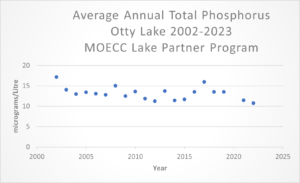
Nitrogen Measurements
In addition to Phosphorus, Nitrogen is also an essential nutrient to support a living lake. The OLA has initiated a measurement program for nitrogen by sampling for Total Kjeldahl Nitrogen (TKN). The provincial objective is 0.5 milligrams/Litre for TKN.
Like many lakes in Ontario, Otty Lake is regarded as “phosphorus limited”. That means that of the main nutrients, phosphorus is the one with the smallest availability relative to the amount required to support aquatic species. Hence the amount of phosphorous at Otty Lake is key to supporting or limiting aquatic life. Nevertheless, it is important to reduce all nutrient inputs to the lake. Excessive nutrients levels in the lake can lead to profuse algal blooms and aquatic plant growth.
Water Clarity
Water clarity is measured by observing the maximum depth at which a Secchi disk is visible from the lake surface. These measurements are taken at least once a month from May to October. These results are reported to the MOEPC Lake Partner Program for comparison with the other 600 participating lakes in Ontario.
Annual average water clarity measurements at Otty Lake for 1971–2018 and from 2020-2023 are presented in the following charts. Veligers of Zebra Mussels were first identified at Otty Lake in 2001. An increase in water clarity can be observed in succeeding years.
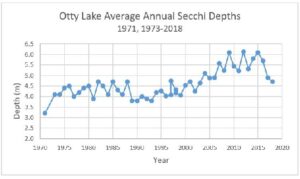
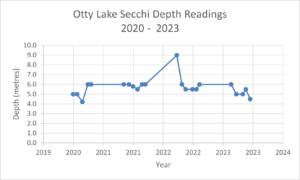
Dissolved Oxygen – Why it Matters
Animal Life. An important aspect of the health of a lake is the amount of dissolved oxygen found in the lake water at various depths. Dissolved oxygen is essential to support a range of species from fish and insects to zooplankton. Some species, such as trout, require larger amounts of dissolved oxygen, particularly at depth. Other species such as carp and many types of zooplankton have adapted to live with low amounts of dissolved oxygen.
Oxygen from Air Exposure. Generally oxygen is dissolved in the lake water from exposure to air. For the climate at Otty Lake, there is no exposure of the lake to air during the ice-covered winter months and no dissolved oxygen is added. During this period the lake water is at a near-constant temperature of 4°C except near the top where it is colder. Immediately after the ice break-up, the lake water mixes completely and the dissolved oxygen is generally uniform from top-to-bottom.
The Thermocline. About a week or two after the ice break-up, the upper portion of the lake begins to warm up. As the warmer water is less dense, and Otty is sufficiently deep, stratification (spring overturn) of the lake occurs with an upper layer of warmer water and a much colder layer below. The upper, warmer layer is continually oxygenated during the ice-out period as wind mixes this water bringing it in contact with the air. The dividing line between the warmer and colder layers is called the thermocline and for Otty this is at about 7 or 8 metres of depth.
Colder water is capable of holding more dissolved oxygen than warmer water. Nevertheless, the dissolved oxygen in the colder, lower layer of the lake will become depleted throughout the summer as this lower layer of water is isolated from the air and the dissolved oxygen in this lower layer is consumed by various organisms including fungi and bacteria that break down dead material lying on the lake bottom. Generally the dissolved oxygen in the lower portion of a lake like Otty will continue to decline until the fall. In the fall, cooler air temperatures will cause the upper water layer to cool causing a complete mixing of the lake (fall overturn) when the temperature in the upper layer falls to that of the lower layer. At this time the thermocline disappears. This mixing will continue for a few weeks until ice forms on the lake surface.
Measuring Oxygen Levels. The Rideau Valley Conservation Authority (RVCA) undertakes water quality sampling and measurements on Otty and McLaren Lakes with the assistance of Otty Lake Association volunteers. Among these tests the RVCA measures dissolved oxygen/temperature profiles (DO/T) at a mid-lake deep point at Otty and also McLaren, four times a year.
McLaren Lake is situated about 70 metres upstream from Mud Lake and the Little Otty. It is a small, relatively deep, lake. The thermocline is shallower, and that the dissolved oxygen levels are much less, than at Otty.
